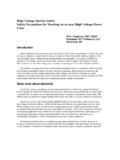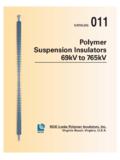Transcription of The Effects Of High Or Low Voltage On The …
1 August Cyndi NybergEASA Technical Support SpecialistNEMA states that motors shalloperate successfully under running conditions atrated load with a variation in the Voltage or thefrequency up to the following:a. Plus or minus 10 percent of rated Voltage , withrated Plus or minus 5 percent of rated frequency, withrated A combined variation in Voltage and frequencyof 10 percent (sum of total values) of the ratedvalues, provided thefrequency variation doesnot exceed plus or minus5 percent of is usually noproblem with frequencyvariation, unless we get intooperating at 50 Hz, but thatwould be an article all byitself, so the focus here willbe on Voltage variation though NEMA statesthat motors are designed tooperate within 10 percent ofrated Voltage , that doesn tgive an accurate picture ofwhat will happen when amotor is operated with highor low Voltage . Any changefrom the rated Voltage andfrequency will affect theperformance of the motor,sometimes s standard T-framemotors are designed withhigh flux densities andtherefore are more suscep-tible to improper voltageconditions that will motors and highefficiency motors are designed with lower fluxdensities, so any variation from the rated Voltage willnot affect the performance as much (but it may stillhave negative Effects !)
2 Higher Voltage equals higher flux, so in somesituations, high voltagecan actually improve theperformance, but atsome point the core willbegin to saturate andheat up a low voltagesupply is more danger-ous than high Voltage ,because as less voltageis applied, there is lessflux in the iron. Less flux means the core iron isnot being used to its optimal level, so efficiencyand torque start to often than not, yourcustomer will have a highvoltage supply, but there arecases where it may be low. Forexample, you could have amotor designed for 440v, but thepower supply is actually 485v or490v, which is right on the edgeof 10 percent over Voltage . Oryou could have a motor designedfor 230v, and the power supplyis only 208v, right on the edge of10 percent under following is a summaryof the Effects of over and undervoltage for typical inductionmotors:TorqueThe torque of an inductionmotor varies as the square of thevoltage, so any small variation involtage will significantly affectthe starting and maximumtorque.
3 At 110 percent Voltage ,torque will increase by 21percent, but at 90 percentvoltage, the torque will decreaseby 19 percent. This could be aproblem if the motor needs tostart a high inertia speed of a motor is going to change slightlywith high or low Voltage . At 110 percent Voltage ,The Effects Of high Or Low VoltageOn The performance Of A MotorThis chart shows a summary of the typicaleffects of high and low Voltage on theperformance of a motor. When rewinding amotor that you know does not match thecustomers Voltage supply, consider changingthe design slightly to meet the exact voltagerequirements. This will ensure that the motorwill perform at its optimal level.+20+15+10+50-5-10-15-20-15 -10 -50+5 +10 + ANDMAXIMUM TORQUEEFF. *STARTING AMPSSTARTING ANDMAXIMUM TORQUESTARTING AMPSPERCENT CHANGES IN MOTOR PERFORMANCEPERCENT Voltage AMPS* Note: Efficiency may increase or decrease dependingupon motor Of Voltage .
4 Continuedthe speed will increase about 1 percent, and at 90percent Voltage it will decrease about when you look at the speed change in percentslip, the numbers are more dramatic. At 110percent Voltage , the percent slip will decrease by17 percent, but at 90 percent Voltage , the slip willincrease by 23 110 percent Voltage , the efficiency of amotor may actually increase up to 1 , at 90 percent Voltage , the efficiency isgoing to decrease about 2 percent. This willespecially be a factor to consider for larger motorsbecause of the cost of a lower starting and full load current will also beaffected by changes in Voltage . At 110 percentvoltage, the starting current will go up 10-12percent, but the full load current will go down 7percent. This would be a problem if the powersupply cannot handle the higher starting 90 percent Voltage , the starting current willdecrease 10-12 percent, while the full load currentwill increase 11 RiseThe temperature rise at full load will be some-what affected by variations in Voltage .
5 At 110percent Voltage , the temperature rise will decrease3-4 C, unless the core has become saturated (thetemperature would increase). At 90 percentvoltage, the temperature rise is going to increase 6-7 C. A general rule is that for every 10 C increasein total temperature rise, the insulation life will becut in half. Even a slight under- Voltage is going toincrease the temperature, so that can make adifference in the insulation life of the CapacityAt 110 percent Voltage , the motor will actuallyhave a 21 percent higher overload capacity, but at90 percent, the capacity will decrease by 19percent. More often than not, a motor is going tobe overloaded for some period of time, so if themotor is operating with under- Voltage , thepossibility of failure Making Your s Time To Order 2000 EASA Holiday CardsAnother way to keep your name in front ofcustomers is through EASA s newly designed2000 holiday card.
6 A sample card and order formare enclosed with this ManualIndex EnclosedA Technical Manual index is enclosed forActive and Allied very detailed index will make it easier tofind articles, tables, and topics in the nearly 700-page insert this index into Section 19 of yourTechnical extra copiesof the index using theenclosed order DeathOrder your supply now by completing the formand returning itto MRI byOctober 4. Thispromotion willbe offered Peg Stella, 62, of Slate Run,Pennsylvania, died on May served as the first secretary of HightsElectric Motor Service, Inc. in Hightstown, NewJersey in 1972. She was an active member of theQuaker City Chapter. Survivors include her mother, Margaret Yaussi; herhusband, Bernard Bucky Stella, two sons, Kennethand Bernard Buck Stella Jr.; two daughters, DonnaStella-Edwards and Pamela Stella; a brother, John;four grandchildren, many nieces and nephews.






